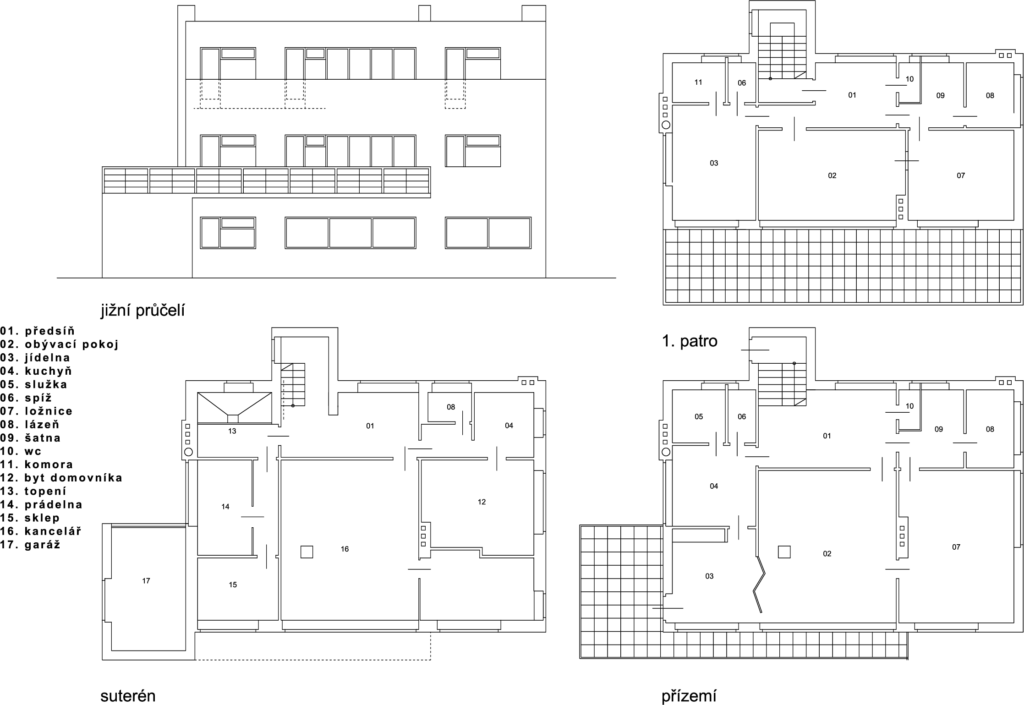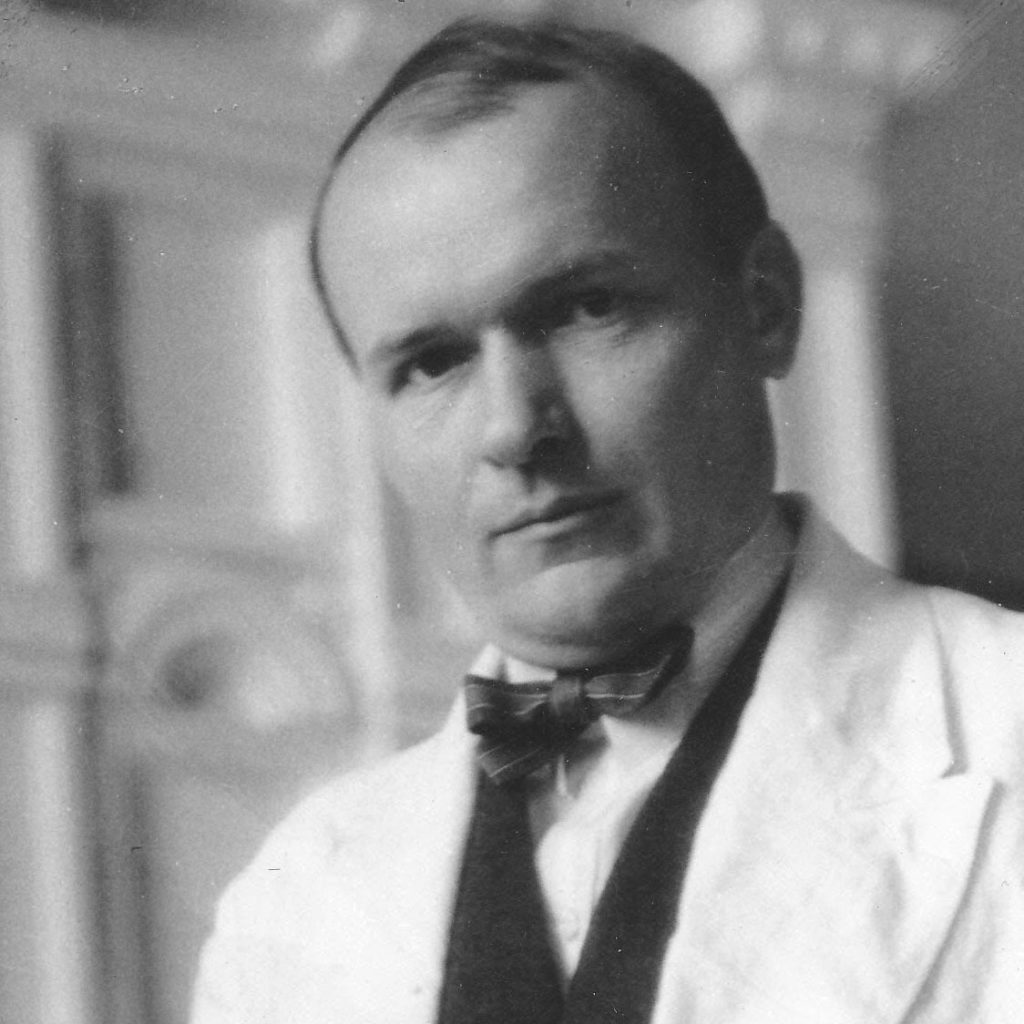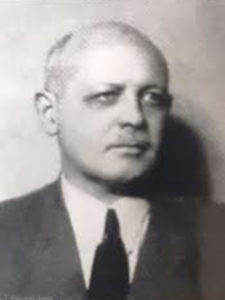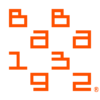
The House of Ing. Karel Dovolil
Pavel Janák designed the two-generation house for his friend and a great advocate of functionalism, Karel Dovolil. He made excellent use of the slope of the terrain when positioning the house facilities, investor’s office, and a small apartment for the caretaker. The roof of the separate garage also serves as a terrace connected to the balcony of the room. This terrace is connected to the garden by a steel staircase. The front façade facing the street has windows, unlike the other houses.

Architect
Pavel Janák
(*1882 Prague +1956 Prague)

An architect, urban planner, designer of furniture and decorations, professor at the Academy of Arts, Architecture and Design, and architectural theoretician. He studied technical studies in Prague at both the Czech and German schools, as well as at the Academy of Art in Vienna. He worked with Josef Gočár at Jan Kotěra’s studio. His works go through several distinct phases: his first period is consciously focused on modernism, then he becomes the leading representative of Czech cubism. He then goes through a period of national style only to end up being entirely devoted to functionalism. He was a long-standing president of the Czechoslovak Werkbund, the main initiator of the functionalist Baba estate, and the author of Baba’s urban plans. In the Baba estate, he designed the Dovolil House as well as his own house.
1899-1905
studied architecture at CTU in Prague
1902-1903
studied at the German Technical High School in Prague
1906-1907
studied at the Academy of Fine Arts in Vienna with Otto Wagner
1907-1908
cooperated with the studio of Professor Jan Kotěra in Prague, study trips to Italy
1908
member of the Mánes Union of Fine Arts
1909-1910
employed in the Department of Construction of the Prague City Hall
1911
independent architect in Prague
member of the Group of Fine Artists in Prague
1912
co-founder of the Prague Art Workshops (PUD)
1914-1918
military service
1919
state exam at the Czech Technical University in Prague
1921
Professor at the Academy of Arts, Architecture, and Design in Prague
member of the Czech Academy of Sciences and Arts
1924-1945
President of the Czechoslovak Werkbund (SČSD)
1935
corresponding member of the Moscow Academy of Architecture
1936-1956
architect of Prague Castle
Significant Works
1909-1910
Hlávka’s Bridge in Prague
1911
Jakubec house, Jičín
1912-1913
reconstruction of Dr. Fára’s house, Pelhřimov
1913-1914
weir on the River Labe, Předměřice 1
1914
Villa Pick, Ljubljana
1922
crematorium, Pardubice
1922-1924
Riunione adriatica di Sicurta, Prague-Nové Město (with Josef Zasche)
1923-1924
artists’ colony (villas of J. Benda, B. Kafka, E. Filla and V. Beneš), Prague-Ořechovka
1924-1926
Škoda Palace, Prague-Nové Město
Czech Autoclub building, Prague-Nové Město
1924-1928
Libeň Bridge, Prague
1925-1934
reconstruction and extension of the Czernin Palace, Prague-Hradčany
1927
airport, Mariánské Lázně
1927-1928
pavilion of the Academy of Arts, Architecture, and Design at the Brno Exhibition Centre
1927-1929
block of cooperative houses, Prague-Dejvice
1929-1932
building plan of the Baba Housing Estate, Prague-Dejvice
1932
houses of Pavla and Václav Linda and Ing. Karel Dovolil and his own house, Baba, Prague-Dejvice
Juliš Hotel, Prague-Nové Město
Congregation of the Czechoslovak Hussite Church, Prague-Vinohrady
1934-1935
villa with a studio for the sculptor Josef Mařatka, Prague-Střešovice
1948-1950
renovation of the Riding Hall, extension of garages and terraces, Prague Castle
1950
renovation of the Hall of Ball Games, Prague Castle
Owner
Karel Dovolil

In 1932, Ing. Karel Dovolil (1899-1955) moved into his new home with his wife Jarmila and first daughter, also called Jarmila. His wife Jarmila was a bold and active woman for that time. To her, the functionalist-style window to the kitchen seemed to provide insufficient light, so despite Janák’s proposal, she negotiated with the workmen to enlarge the window, which surprised her husband when he came home from work. The famous architect was hurt by this purely practical female decision. In the Protectorate period, like many other Jewish residents of the villas, Karel Dovolil had to face bullying from his infamous neighbour in Baba, the Czech Nazi Bautz, but he was also forced to close down his engineering practice. He worked for his brother-in-law in his paper company until nationalisation. However, he was not allowed to continue in his line of business. He worked as a water manager at VODOTECHNA until his sudden death. His daughters Jarmila and Hana still live in this unique two-generation house in Baba today.

